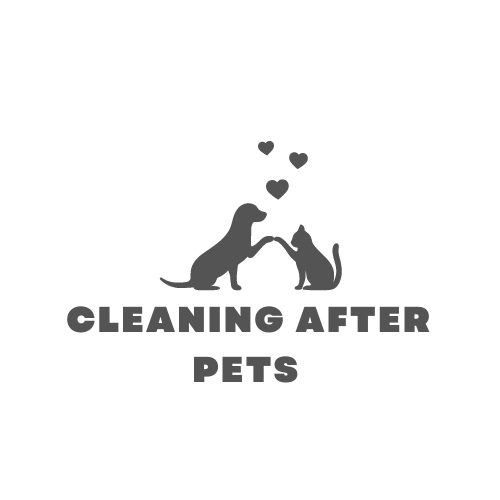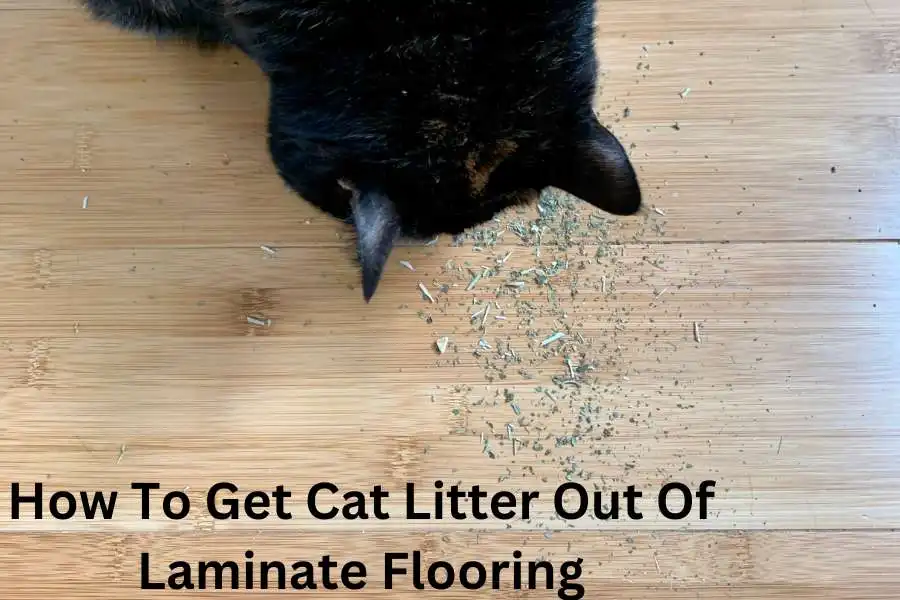As a cat owner, cleaning up after your feline friend can be a daily chore. One of the challenges of having a cat is dealing with scattered cat litter before it scratches the floor. Removing litter from laminate floors without damaging them can be tricky.
As with most stain-removing tasks, the secret is not to allow the litter to sit for long and to use the right techniques and cleaning products.
How to get cat litter out of laminate floors is not precisely the same as how you clean cat litter off of hardwood or vinyl floors. Laminate floors are unique in their own right – although they may look like and be just as appealing as hardwood floors, the two types have separate cleaning procedures.
Laminate floors require special care because you cannot refinish them easily if they are stained or scratched. Luckily, laminate floors are durable and easy to care for. However, excess water or liquids can damage them easily.
This article will provide tips on removing cat litter from laminate floors without damaging them and ensuring the stain does not reappear when it dries.
How To Clean Laminate Floors Without Leaving A Film

Here is a step-by-step guide you can use to get cat litter off laminate floors:
Step #1: Sweep The Area
Before cleaning, sweep the area to remove loose litter particles. This will make it easier to clean the remaining litter and prevent scratches or damage to your laminate floor. Use a soft-bristled broom to sweep the area thoroughly and remove the larger litter particles, dander, pollen, and other unwanted waste on your floor.
When using a broom, sweep the litter into a pile before disposing of it. Use the lowest suction setting to avoid scratching the laminate floor for vacuuming.
Step #2: Use A Lint Roller
If you have any small or hard-to-reach areas where litter has accumulated, you can use a lint roller to remove it. Roll the lint roller over the affected area, applying light pressure to pick up the litter. Move the lint roller in different directions to ensure you pick up all the cat litter.
When the sticky strip is fully covered with cat litter, peel it off, throw it in the trash, and replace it with a new strip. Repeat this process until all the litter has been removed.
A lint roller removes litter from corners or tight spaces where brooms or mops cannot reach effectively and easily. However, it may be less effective for larger areas and may compel you to do a lot of work.
Step #3: Use A Vacuum Cleaner
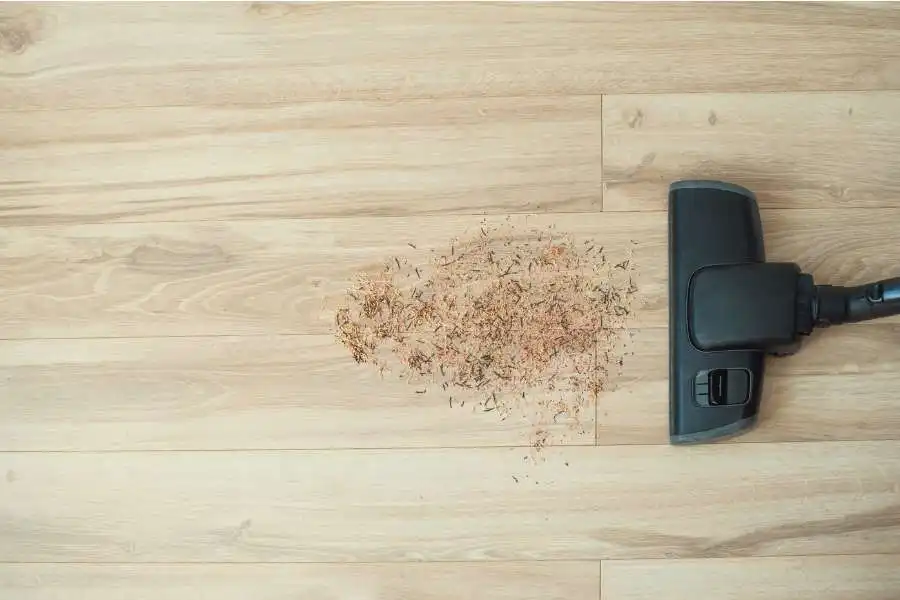
If you have a vacuum cleaner with a hard floor attachment, you can use it to remove any remaining litter. It is suitable for eliminating cat litter from expansive areas of your laminate flooring.
Set the vacuum cleaner to the lowest suction setting to avoid scratching your laminate floor. If you don’t have a hard floor attachment, use a handheld vacuum cleaner or a dustpan and brush to clean the area. Importantly, never use an attachment with a rotating brush or beater bar. These attachments tend to scratch the laminate flooring.
Hold a handheld vacuum cleaner a few inches above the floor to avoid scratching the laminate floor. This vacuuming technique helps you avoid dragging litter across the floor.
Ensure that you run the vacuum cleaner over the entire patch to remove any remaining cat litter particles. In addition, use the crevice tool attachment to reach tight spaces, including any grooves on your flooring where cat litter debris may be caught between the floorboards.
Step #4: Use A Damp Cloth Or A Microfiber Mop
Once you have removed any loose litter particles, you can use a damp cloth or mop to clean the remaining litter. Soak the cloth (preferably a Swiffer) or microfiber mop in soapy water and wring out the excess water.
Most laminate floor manufacturers recommend using a microfiber mop instead of the traditional mop because the strings of the latter have high absorbency properties and are more likely to soak the floor.
Take caution not to use a lot of water while mopping laminate floors. The excess liquid can seep through the seams of the flooring and lead to swelling and/or bubbling of the floor, thus damaging the floor. This excess water can also cause permanent discoloration or staining.
Gently wipe the area with a slightly damp cloth or mop. You can also add a small cleaning solution to the water to help remove any stubborn litter particles.
Also, avoid using abrasive cleaners or tools, which can scratch the laminate floor. If you need to scrub, use a damp cloth or a soft-bristled brush to remove litter stuck on the floor. A mild cleaning solution, such as dish soap and water, is recommended.
Remember to rinse the mop frequently to avoid spreading the litter around the floor.
Learn How To Get Cat Litter Out Of Carpets
How To Get Rid Of Cat Urine Odor From Laminate Floors
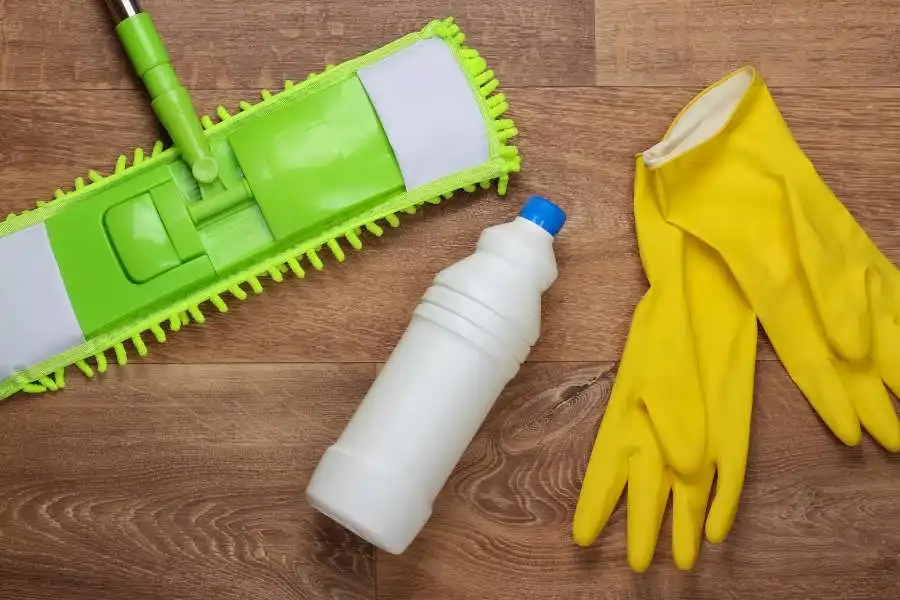
Sweeping, vacuuming, and mopping your laminate floor will eliminate all cat litter granules. However, cleaning your laminate floor might not get rid of the odor. You should take an extra step to clear the remaining evidence of a cat litter mess on your laminate floor.
Here’s how you can clean cat urine and poop odor from your laminate floor:
Using Hydrogen Peroxide
Hydrogen Peroxide can be used as an effective DIY method of removing cat litter stains, cat urine, and poop odors from laminate floors. It is best applied as a follow-up method after removing as much litter debris as possible using the previously mentioned steps.
Prepare a hydrogen peroxide cat litter cleaner by combining 1 part hydrogen peroxide and 2 parts water and mixing them in a spray bottle.
Next, spray the cat litter patch and ensure you do not saturate the laminate floor, which can damage the surface. Allow the hydrogen peroxide to sit on the patch for about 5 minutes, and wipe off the solution with a clean and damp cloth to rinse the hydrogen peroxide solution.
You may need to repeat this step until all the cat litter stains are gone. At that point, let the area air dry completely or dry it with a clean towel.
Remember, testing the hydrogen peroxide on an inconspicuous area is always important to protect your laminate floor from damage or discoloration.
Using White Vinegar
Applying a solution of white vinegar and water is another effective DIY method of removing the cat litter smell from your laminate flooring. Like in the case of hydrogen peroxide, clean off the cat litter using white vinegar after removing as much litter as possible using the previously highlighted steps.
Mix equal parts of white vinegar and water in a spray bottle. Remember, testing the white vinegar solution on an inconspicuous area is always important to protect your laminate floor from damage or discoloration.
Then, spray the vinegar solution on the cat litter stain without saturating it. Allow it to sit on the area for about five minutes, and wipe it off with a clean and damp cloth to remove the vinegar.
You may need to repeat this step until all cat litter stains are gone. At that point, let the area air dry completely or dry it with a clean towel.
If you cannot achieve the desired results, consider advancing to specialized cleaners for laminate floors to remove any lingering cat litter stains.
Specialized Cleaners For Laminate Floors
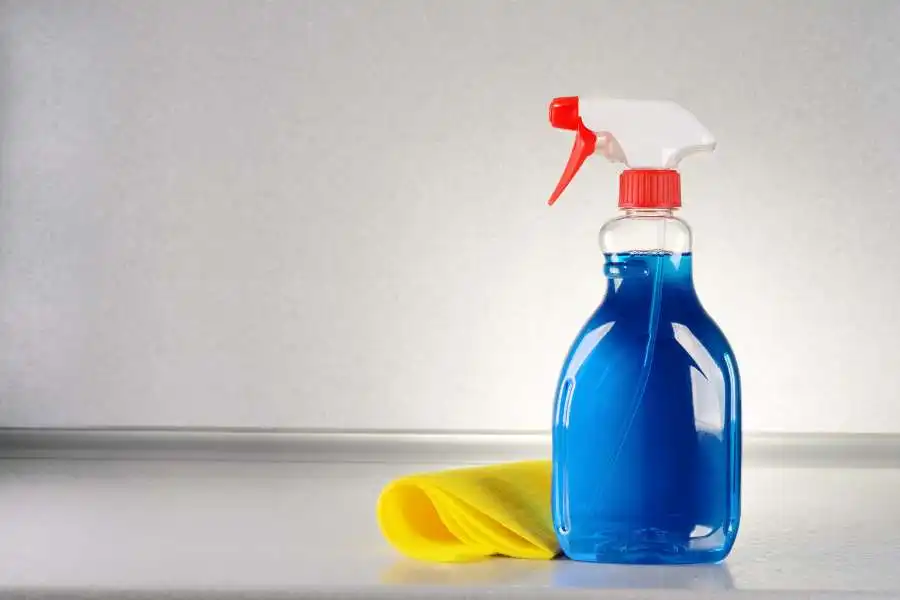
Consider using specialized cleaners for laminate floors. It is always helpful to attempt to remove as much cat litter as possible before using specialized cleaners on your laminate flooring. Deploy the specialized laminate floor cleaning solution after sweeping, vacuuming, and wiping the floor with a damp cloth.
Then, apply the specialized cleaner to the dirty patch and allow it to sit for 5 minutes to break down the stains. Use a soft and clean cloth to scrub the stain out.
Rinse the cloth with clean water and wash off the spot to remove any residual cleaning product. Allow the area to air dry completely, or use a clean towel to remove the moisture.
More notably, it is vital that you read and carefully follow the manufacturer’s instructions for use on any cleaner you use. Some of the available cleaning options include:
- Bona Stone, Tile, and Laminate Floor Cleaner: This water-based cleaner is specifically designed for laminate floors. It is easy to use as it only needs to be sprayed on the floor.
- Black Diamond Wood & Laminate Floor Cleaner: It is safe for all laminate floors as it is pH balanced. It is also biodegradable.
- Bruce Hardwood and Laminate Floor Cleaner: specially formulated to clean and safeguard laminate floors. It is easy to use. It is safe to use as it dries quickly.
Other safe options for laminate floors are Weiman Hardwood Floor Cleaner, Goo Gone Pro-Power Cleaner, Zep Hardwood and Laminate Floor Cleaner, Rejuvenate All Floors Cleaner, and Quick Shine Multi-Surface Floor Cleaner.
Top Tips For Keeping Cat Litter Off the Laminate Floor
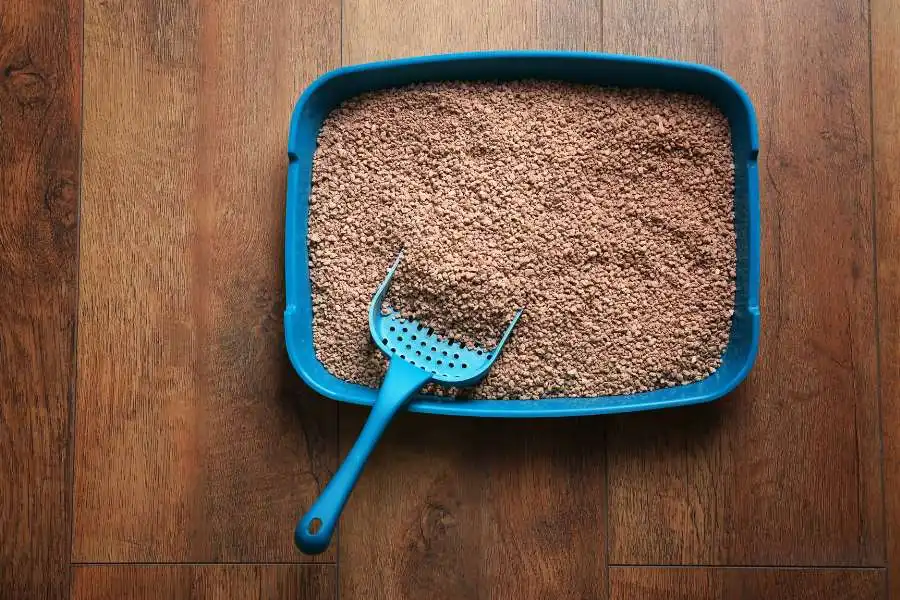
You’ve learned how to get cat litter out of laminate floors. However, it would be better to avoid cat litter messing up your laminate floor. Below are some tips to help prevent cat litter from messing up your floor.
#1. Use The Right Litter Box
Providing your cat with the right litter box can help keep cat litter away from laminate floors. Please note that the right litter box is the one your cat is comfortable using all the time when it has to go to the bathroom.
Using an enclosed litter box or one with high sides helps reduce the scattering of litter or the amount of litter your cat kicks out of the box and ends up on your floor.
The high sides make it difficult for the cat to spray the litter around, especially if the cat loves to dig forcefully in the litter.
#2. Use The Right Cat Litter
Providing your cat with the right litter is another hack that helps keep cat litter off your laminate floors. You may consider buying cat litter designed to reduce tracking, as it rarely gets stuck on the cat’s paws.
Alternatively, consider buying natural or ‘dust-free’ cat litter to reduce the litter debris that settles on your floors. Although no cat litter is completely dust-free, there are various cat litter options that produce less dust when used in the litter box.
These low-dust litter types also reduce the frequency of vacuuming and sweeping the floor.
#3. Get A Litter Mat
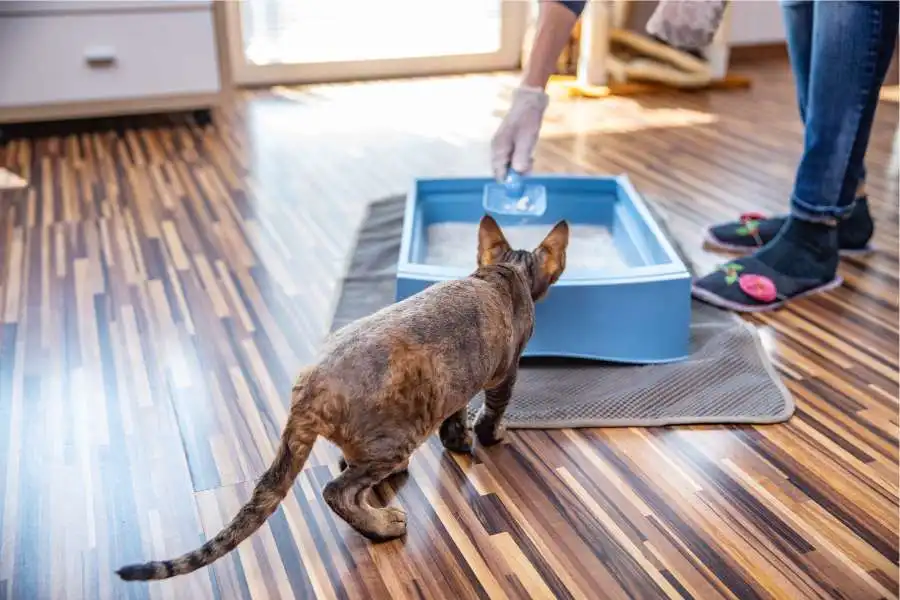
Consider laying a suitable mat below the litter box to catch the litter debris that tracks out or is thrown out by your cat. It also traps the litter caught on your cat’s paws as they get out of the litter box, effectively keeping this litter off your floor.
A litter mat reduces the scattering of litter outside the litter box and protects the floor area immediately adjacent to the litter box from litter and the consequent scratches from the abrasive litter debris thrown out of the litter box.
Ideally, look for a mat that is easy to clean or vacuum. For example, you can look for a machine-washable mat with a textured surface to provide sufficient non-slip support for your cat. Generally, a litter mat reduces the amount of litter you have to vacuum up from your floor and limits the spread of bacteria from the litter box.
#4. Maintain A Regular Cleaning Schedule

Creating a regular cleaning schedule is one of the most effective ways to keep cat litter stains off your floors. Cleaning and vacuuming your floors regularly helps reduce the buildup of cat litter on various sections of your laminate flooring. Litter buildup on your floors may scratch or discolor the floor.
Regularly cleaning the floor stops the spread of odors and boosts the hygiene standards in your home and the environment.
Learn How To Get Cat Litter Out Of Concrete Floors
How To Get Cat Litter Out Of Laminate Floor: Conclusion
Cleaning cat litter from laminate floors can end in disaster if you do not know what you’re doing. That said, it doesn’t have to be difficult. By following the tips outlined in this article, you can remove cat litter from your floors without causing any damage.
Remember to sweep or vacuum the area first, then use a damp cloth or mop to clean the remaining litter. You can use a lint roller or vacuum cleaner to clean hard-to-reach areas if necessary. Always use gentle, non-abrasive cleaning solutions to avoid scratching the floor.
In addition to cleaning up cat litter, it’s also important to maintain a regular cleaning routine to keep your floors in good condition. This includes sweeping or vacuuming regularly, cleaning up spills promptly, and avoiding abrasive cleaning tools and solutions.
By following these tips, you can keep your laminate floors looking clean and beautiful for years.
FAQs
Q. Can I use bleach to clean cat litter from my laminate floors?
A. No. You should avoid using bleach or other abrasive cleaners as they can damage the floor’s finish. Instead, use a gentle, non-abrasive cleaning solution and a slightly damp cloth or mop.
Q. How often should I clean my floors to prevent cat litter buildup?
A. It’s best to clean up cat litter as soon as possible to prevent buildup. Sweep or vacuum the area daily, and do a deeper clean once a week.
Q. Can I use a steam mop to clean cat litter from my laminate floors?
A. It’s not recommended to use a steam mop on laminate floors, as the high heat can cause damage to the finish. Stick to using a damp cloth or mop with a gentle cleaning solution.
Q. What should I do if my cat continues to kick litter out of the box onto the floor?
A. Consider getting a larger litter box or one with higher sides to prevent litter from spilling out. You can also try placing a mat or tray under the box to catch any stray litter.
Q. What should I do if my cat urinates on the floor instead of in the litter box?
A. Clean up any urine immediately to prevent damage to the floor. Use an enzymatic cleaner specifically designed for pet urine to remove the odor and prevent your cat from returning to the same spot. Consider taking your cat to the vet to rule out any medical issues causing them to avoid the litter box.
